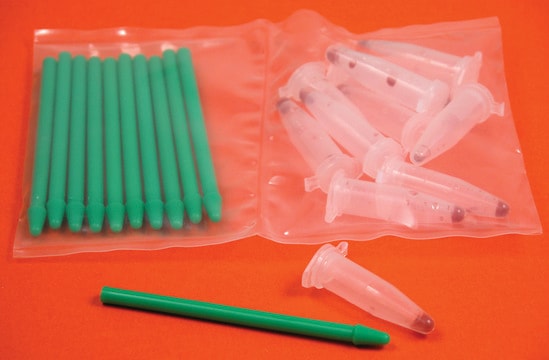D8938
KIMBLE Dounce tissue grinder set
2 mL complete
Synonym(s):
885300-0002, Dounce, Dounce Homogenizer, Glass Tissue Grinder, KIMBLE Tissue Grinder, KONTES, Pestles, Tissue Grinder, Tubes
Sign Into View Organizational & Contract Pricing
All Photos(2)
About This Item
UNSPSC Code:
41121800
NACRES:
NB.22
Recommended Products
material
glass
feature
autoclavable
manufacturer/tradename
Kimble® 885300-0002
pestle A clearance
0.0030-0.0050 in.
pestle B clearance
0.0005-0.0025 in.
working volume × L
2 mL × 60 mm
Looking for similar products? Visit Product Comparison Guide
General description
Designed primarily for cellular work where the nucleus remains intact after homogenization. All-glass construction. Two pestles are supplied with each complete set. Large clearance pestle is used for the initial sample reduction. Small clearance pestle is used to form the final homogenate.
Features and Benefits
• Manufactured from borosilicate glass 3.3• Designed primarily for cellular work where the nucleus remains intact after homogenization.• All-glass construction• Two pestles are supplied with each complete unit• Large clearance pestle is used for the initial sample reduction• Small clearance pestle is used to form the final homogenate• Replacement components are available and completely interchangeable
Legal Information
KIMBLE is a registered trademark of DWK Life Sciences
Certificates of Analysis (COA)
Search for Certificates of Analysis (COA) by entering the products Lot/Batch Number. Lot and Batch Numbers can be found on a product’s label following the words ‘Lot’ or ‘Batch’.
Already Own This Product?
Find documentation for the products that you have recently purchased in the Document Library.
Customers Also Viewed
Naomi Habib et al.
Nature neuroscience, 23(6), 701-706 (2020-04-29)
The role of non-neuronal cells in Alzheimer's disease progression has not been fully elucidated. Using single-nucleus RNA sequencing, we identified a population of disease-associated astrocytes in an Alzheimer's disease mouse model. These disease-associated astrocytes appeared at early disease stages and
Fang-Yuan Hu et al.
Frontiers in bioengineering and biotechnology, 8, 564057-564057 (2020-10-20)
Retina is a crucial tissue for capturing and processing light stimulus. It is critical to describe the characteristics of retina at the single-cell level for understanding its biological functions. A variety of abnormalities in terms of morphology and function are
Sripriya Ravindra Kumar et al.
Nature methods, 17(5), 541-550 (2020-04-22)
Recombinant adeno-associated viruses (rAAVs) are efficient gene delivery vectors via intravenous delivery; however, natural serotypes display a finite set of tropisms. To expand their utility, we evolved AAV capsids to efficiently transduce specific cell types in adult mouse brains. Building
Jonathan M Levy et al.
Nature biomedical engineering, 4(1), 97-110 (2020-01-16)
The success of base editors for the study and treatment of genetic diseases depends on the ability to deliver them in vivo to the relevant cell types. Delivery via adeno-associated viruses (AAVs) is limited by AAV packaging capacity, which precludes
Nur Jury et al.
Clinical epigenetics, 12(1), 32-32 (2020-02-20)
Hexanucleotide repeat expansions of the G4C2 motif in a non-coding region of the C9ORF72 gene are the most common genetic cause of amyotrophic lateral sclerosis (ALS) and frontotemporal dementia (FTD). Tissues from C9ALS/FTD patients and from mouse models of ALS
Our team of scientists has experience in all areas of research including Life Science, Material Science, Chemical Synthesis, Chromatography, Analytical and many others.
Contact Technical Service











